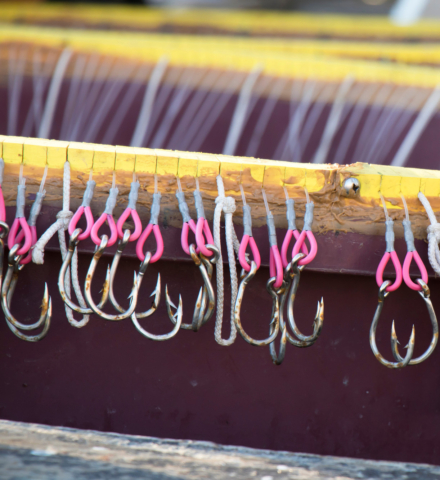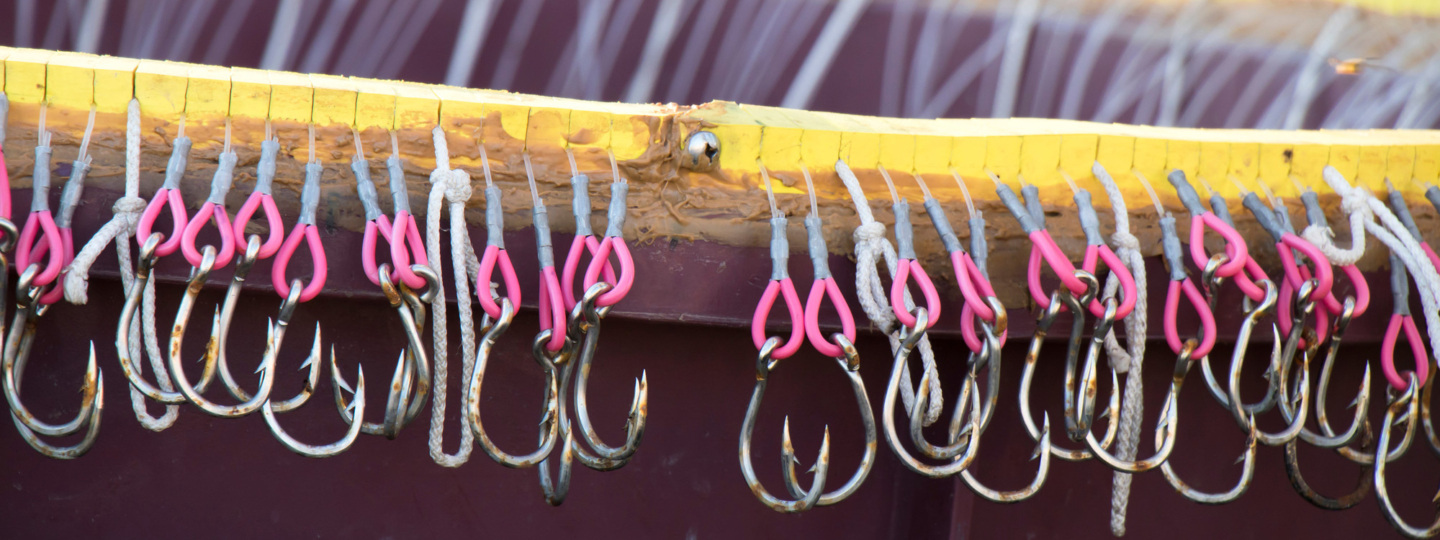Longline
Indian Ocean
Longlines consist of hundreds to thousands of baited hooks that branch off a mainline that can be miles long. Depending on target species, longlines are deployed either in the open ocean (pelagic fisheries) or along the ocean bottom (benthic fisheries).


Target Species
Tuna
Mahi
Swordfish
Groundfish
Bycatch Species
Sea Turtles
Seabirds
Sharks and Rays
Solutions
View allFunding Opportunities
View allDescription
Research suggests that over 300,000 whales and dolphins die annually due to entanglement in fishing gear, with additional unknown numbers also entangled in marine debris. This can have devastating, long-term conservation impacts on those populations that are already threatened, in some cases critically. In response to these growing concerns, the International Whaling Commission (IWC) launched a Global Whale Entanglement Response Network (GWERN) in 2011. The immediate aim of the program was to build safe and effective entanglement response capability around the world. The long-term goal is to prevent entanglements incidence globally.
The program is a partnership with the Center for Coastal Studies (CCS) in Provincetown, Massachusetts, US considered one of the global leaders in entanglement response. It is led by Technical Advisors who work for both CCS and the IWC, supported by an Expert Panel drawn from countries with long-standing and well-tested approaches to entanglement response.
With assistance from this global expert group, a Best Practice Guidelines and a two-day entanglement response training package has been development and is in need of further support. The training workshop includes classroom study, with information on data collection, relevant regulations, and regional cetacean identification, followed by on the water, hands-on disentanglement exercises. Since 2012, these training workshops have been delivered across five continents, reaching over 1,700 participants from more than 43 countries.
Funding to support this program includes equipment costs for disentanglement kits and trainer sponsorship consisting of flights, subsistence and a $205/day trainer fee. Additionally, a smaller funding package to support disengagement kit supplies alone is available.
Beneficiary: International Whaling Commission in partnership with Center for Coastal Studies
- Funding to support equipment costs for disentanglement kits and trainer sponsorship $18,944 USD
Description
Albatrosses and other seabirds are facing a conservation crisis worldwide. Tuna fishing is a key threat, with tens of thousands of seabirds becoming hooked and drowning each year.
A new seabird-safe tuna hook (called the Procella hook) provides fishers with a simple way to reduce seabird deaths. This hook is weighted so it sinks quickly when the longline is being set. Seabirds have little time to grab the baited hook before it is below the depth they can dive to. Several prototypes of the Procella hook have been trialed in New Zealand by three leading tuna skippers. The fishers report excellent target catch and very low seabird captures with the finalized design. This self-reported feedback has been confirmed through government on-board cameras.
The next step is to manufacture the Procella hook and create interest and uptake by making the hook available to a broader group of skippers in the New Zealand tuna fleet and selected international tuna fleets. Target catch and fishing effort data from participating vessels will be used to produce scientific reports and marketing materials. The Procella design is easily adapted to a multitude of hook types and any hook factory can tailor the product to their customers’ needs.
The Procella hook is safer for crew than traditional line weighting options and has the advantage of making compliance checking simple and reliable. And most importantly, the skippers involved in the project have proven to themselves the Procella hook is good for fishing.
Want to know more? Contact SFP’s Bycatch Hub Manager for more specifics on the project workplan and a line-item budget.
Beneficiary: Southern Seabirds Trust
- To establish the seabird-safe Procella hook as market ready. $48,800 USD
Description
The Namibian Demersal Longline fishery is comprised of 19 vessels operating from Walvis-Bay and Lüderitz. They target Cape hakes using a double line “Spanish-system” with alternate dropper lines and weights. Each set lasts 2–3 hours and deploy an average of 16,500 baited hooks. This gear presents an elevated risk to seabirds because the addition of floats results in hooks being available to seabirds for longer periods of time. 20,000 seabirds were being killed annually in this fishery, mainly White-chinned petrels, but also of Endangered Atlantic yellow-nosed albatrosses. The introduction of Bird-Scaring Lines (BSL) regulation however demonstrated that bycatch can be reduced by >98% if BSLs are properly deployed. While significant efforts have been made by government agencies in Namibia, compliance monitoring relying on human observers is limited and costly. Cameras to monitor the usage of BSL is a cost-effective solution to reach 100% coverage, ensuring highest compliance with regulation.
In this collaboration with the Albatross Task Force, cameras will be deployed on two vessels to monitor the deployment of BSL during fishing operations. On each boat at least one high-definition camera will be deployed and set to capture a picture every 15 min to check BSL compliance according to regulation in Namibia. The use of cameras to capture single shots rather than videos answers privacy concerns onboard and limits the cost to store and manually check large amount of data. For each longline setting, 8- 12 pictures will be recorded per camera. This method has been successfully trialled in an Argentinian Trawl fishery, showing that the adoption of cameras has increased BSL usage from 30% to 82% in less than two years.
This project will last for a year and will be used to develop with an action plan to equip the entire fleet (19 vessels) with this compliance system.
Beneficiary: Namibia Nature Foundation
- EM Implementation for Two Vessels $29,084 USD

